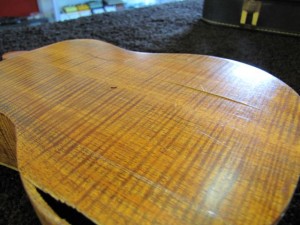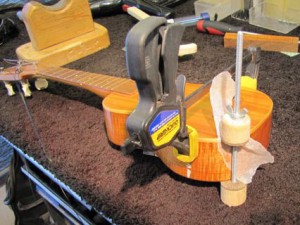Kiefo Nilsson, the son of the late, great Harry Nilsson, brought us his father’s ukulele for an overhaul. This uke had been through the ringer throughout Harry’s illustrious career, having passed through the hands of many notable musicians (such as the Beatles, whom Harry was associated with), and it was in desperate need of some love. Kiefo really wanted this job done right, so he shipped the uke to us for a fix.
We unpacked the uke and inspected the damage: The top was cracked in several places, the binding was coming loose, the back had a large hole in it, and the front, back, and sides were falling apart. The koa wood was beautiful, but over the years the dirt and grime of rock & roll had dulled it’s look and it had lost much of it’s luster.




 The first order of business was to source some flamed koa wood to use to patch the hole in the back. We scoured high and low for some suitable koa, and ended up ordering an entire pile of blanks in hopes that one of them would match. We were fortunate to find one blank from the pile that seemed to match up to the flame on the uke pretty closely, and put the rest in storage for the next project.
The first order of business was to source some flamed koa wood to use to patch the hole in the back. We scoured high and low for some suitable koa, and ended up ordering an entire pile of blanks in hopes that one of them would match. We were fortunate to find one blank from the pile that seemed to match up to the flame on the uke pretty closely, and put the rest in storage for the next project.
We started by securing the front, front, back, sides, and loose binding using a combination of hide glue and spool clamps. We set the uke in a series of clamps, let the glue dry overnight, then glued a different section together, clamped, and waited again.



 Next we fixed the cracks in the back and top. First we flexed the cracks to open them up just a pinch, so we could clean out any foreign debris that may have gotten in there over the years. Then we pressed the cracks back together, checking the fit dry before we applied any glue. Once we were satisfied with the fit, we glued the cracks, clamped them together, and once again waited for the glue to cure. The next day we created a diamond shaped cleat out of koa, and secured it to the inside of the uke across the cracks (positioning the cleat against the grain, which creates a stronger reinforcment), using magnets to get it in it’s proper place. Then we waited yet another day for glue to dry…
Next we fixed the cracks in the back and top. First we flexed the cracks to open them up just a pinch, so we could clean out any foreign debris that may have gotten in there over the years. Then we pressed the cracks back together, checking the fit dry before we applied any glue. Once we were satisfied with the fit, we glued the cracks, clamped them together, and once again waited for the glue to cure. The next day we created a diamond shaped cleat out of koa, and secured it to the inside of the uke across the cracks (positioning the cleat against the grain, which creates a stronger reinforcment), using magnets to get it in it’s proper place. Then we waited yet another day for glue to dry…
 The next step was to fit and shape our koa blank into the hole on the back of the uke. We first squared the hole with a single sided file, to create an even surface to mate the new piece of koa to. We took off just enough of the back to create a straight edge, and then cut our koa blank down to match to the back. We got lucky with our wood order: our blank that we selected matched the flame of the uke almost perfectly! We sanded the new piece smooth, and then glued it in place. And again, we wait…
The next step was to fit and shape our koa blank into the hole on the back of the uke. We first squared the hole with a single sided file, to create an even surface to mate the new piece of koa to. We took off just enough of the back to create a straight edge, and then cut our koa blank down to match to the back. We got lucky with our wood order: our blank that we selected matched the flame of the uke almost perfectly! We sanded the new piece smooth, and then glued it in place. And again, we wait…
The next day we started restoring the uke to it’s former glory. We lightly sanded the entire back, and then hand applied a french polish, which is the same type of finishing process that is used for fine violins. Over the course of a week, we kept adding super thin layers of lacquer, building up the finish on the new wood and allowing it to cure in the sunlight so it would blend in nicely with the rest of the instrument. Then we polished it up and buffed it to a mirror shine.
Kiefo’s uke came out absolutely stunning. This badly abused instrument is now back to it’s former glory, and Kiefo has an heirloom quality instrument that he can pass on to the next generation of Nilssons. Thanks, Kiefo!


This Post Has One Comment
Leave a Reply
You must be logged in to post a comment.



Ah, Harry….I have an all-koa uke…an 8 string baritone…wouldn’t part with it for the world…somehow, the knowledge that one of my all-time favorite song-writers was an uke-man does not surprise me…guess we know where George Harrison got HIS uke-jones, yes?